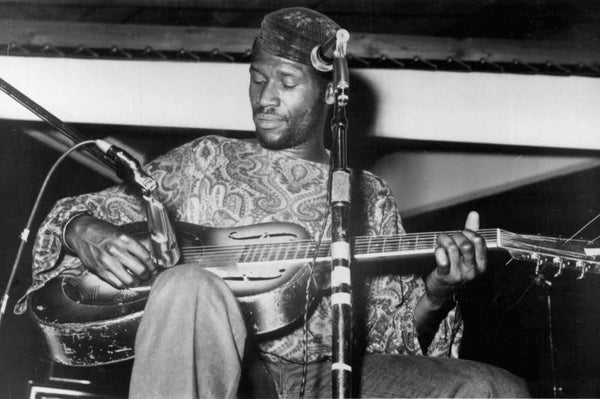Henry St Clair Fredericks Jr – better known as Taj Mahal, is one of the major exponents of Roots music and has been for over fifty years now. Winner of three prestigious Grammy Awards, and nominated fourteen times, Taj is an enduring and remarkably versatile talent; part singer, part songwriter, multi-instrumental maestro and musicologist – his is a remarkable career résumé, and he is one of those artists who occupies his own niche in contemporary music. Taj, alongside the likes of Ry Cooder and Van Dyke Parks has done an incredible job in drawing attention to a veritable kaleidoscopic mix of musical styles but it is perhaps The Blues where Taj has made the greatest impact, and his explorations of the music have won him legions of fans world-wide.
Taj Mahal (his performing name came to him in a dream), had something of a musical upbringing; born on May 17th, 1942, in Harlem, New York, and raised in Springfield, Massachusetts, his father Henry St Clair Fredericks Snr, was of Jamaican lineage, was a Jazz musician and arranger, and his schoolteacher mother sang Gospel. At the age of eleven years old, his father was killed in an accident at his construction company, crushed by a tractor when it flipped over. Obviously, this was extremely traumatic for the young Taj. His mother later remarried and his stepfather owned a guitar which Henry Jr. began using at age thirteen or fourteen, receiving his first lessons from a new neighbour from North Carolina – one Lynwood Perry - of his own age, who played acoustic blues guitar. Perry was the nephew of the Blues legend, Arthur ‘Big Boy’ Crudup. As well as learning the Blues, Taj also sang Doo-Wop in a school vocal combo.
Taj studied animal husbandry at the Amherst College, University of Massachusetts in the early sixties, and began exploring the origins of African American music, and focused on acoustic Blues. At college, he formed a rhythm and blues combo called Taj Mahal & the Elektras, and also worked as a duo with the musician Jesse Lee Kincaid. By 1964, however, Taj had decided to move out West, to Santa Monica, California, and it was there that he formed his first band of note – The Rising Sons.
Apart from Taj, they initially lined up as follows: Jesse Lee Kincaid (guitar), Ed Cassidy (drums), Gary Marker (bass) and Ry Cooder, who sang and played six- and twelve-string guitar, mandolin, slide and bottleneck guitar and dobro, while Taj sang and played harmonica, guitar and piano.
The group began developing a following in Los Angeles around the same time as The Byrds, performing at clubs like the Troubadour and the Ash. Soon, the Rising Sons were signed by Columbia Records, who assigned their hotshot young producer Terry Melcher to the band. The other acts Melcher was producing at the time included Paul Revere & the Raiders - and The Byrds. There was clearly a rivalry with The Byrds, with some preferring the Rising Sons’ authentic folk-blues sound.
The band had no shortage of material to record. Cooder, the son of folklorist parents, was well acquainted with traditional song material, while Mahal and Kincaid, as has been stated, cut their teeth in the folk scene in Cambridge, Massachusetts and absorbed plenty of influences. Armed with at least two dozen folk, blues and country numbers, The Rising Sons went into the studio with Melcher in September ’65 and May ’66. Columbia then rushed out a single, which featured a rollicking version of Rev. Gary Davis’ ‘Candy Man’ and a funky rendition of Skip James’ ‘The Devil’s Got My Woman’. Backed by an initially heavy promotional campaign from their label, the band seemed poised for the big time but then Columbia began dithering about how to market the group: was it rock, blues, country or a little bit of everything? As the album release kept getting postponed, the fighting began, with Melcher, with the label and within The Rising Sons themselves. By the autumn of ’66, the band had imploded.
All of the band’s recordings were consigned to the Columbia tape vaults, where they languished until 1992, when Sony/ CBS released a twenty-two track compilation titled ‘Rising Sons – featuring Taj Mahal and Ry Cooder’ on Compact Disc. “Legendary…Historical…Collectable…Until Now!” read the heading on the back of the CD. It’s true the band had become collectable, as Rising Sons recordings had been widely bootlegged for years, and despite the shambolic demise of The Rising Sons, Columbia Records decided that Taj Mahal held a lot of promise, musically, and signed him as a solo artist.
Back to 1968, and after the demise of The Rising Sons, Taj released two critically acclaimed solo albums – his self-titled debut, and its follow-up, The Natch’l Blues’. The ingenuity present in those albums didn’t translate into sales, but emboldened by the positive response Taj decided to make his next release an ambitious double set, ‘Giant Step’ / ‘De Ole Folks At Home’, which was released in October 1969. Like its two predecessors, the album was produced by David Rubinson. The relationship with Rubinson was a happy and productive one; Rubinson was an ex-Columbia staffer who had worked with the likes of Moby Grape, Santana, Herbie Hancock, The Clancy Brothers, The United States of America, Mongo Santamaria and many others.
Taj opted for two distinct approaches for each disc. Disc One – the ‘Giant Step’ album - was more carefully arranged, and featured his regular backing combo. The second disc, ‘De Ole Folks At Home’ – contrasted sharply with disc one, featuring Taj solo, on acoustic guitars, banjo and harmonica. The album was not a massive commercial success, but certainly consolidated his reputation amongst fans of rootsy music, and also helped raise his profile still further amongst the musician community. Over half a century later, the double set has a freshness, charm and sprightliness that has worn particularly well.
Taj’s career, and his personal and professional life have been through some fascinating changes, but he remains one of the most mercurial and appealing of roots music practitioners. He is still an active musician, particularly on the international festival and live music circuit, and there still seems to be more to come from this most engaging talent.
With thanks to Alan Robinson

